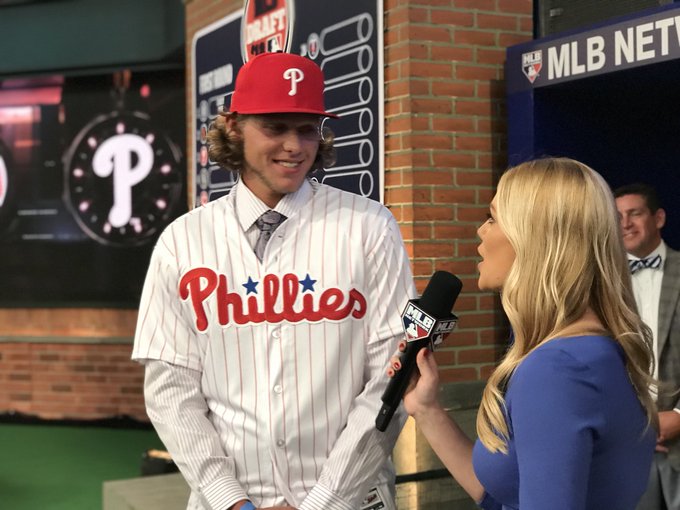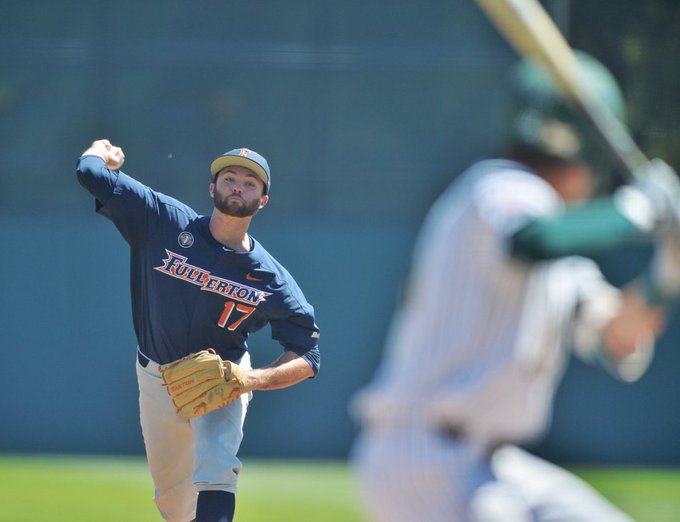Archived
2018 Draft: Phillies picks, bios, signings, etc.
Re: 2018 Draft: Phillies picks, bios, signings, etc.
I dont trust the Phillies and drafting bats in the top 5 anymore.
-

702 - Plays the Game the Right Way

- Posts: 26255
- Joined: Wed Jun 10, 2009 16:41:34
- Location: Vegas
Re: 2018 Draft: Phillies picks, bios, signings, etc.
Bohmmmmmmmmmm
-

Ace Rothstein - BSG MVP

- Posts: 96139
- Joined: Fri Dec 29, 2006 08:06:47
- Location: Tangiers Sportsbook
Re: 2018 Draft: Phillies picks, bios, signings, etc.
Dropped his hat and can’t button his jersey.
-

ReadingPhilly - You've Got to Be Kidding Me!

- Posts: 59729
- Joined: Tue Apr 10, 2007 15:32:14
Re: 2018 Draft: Phillies picks, bios, signings, etc.
FFS, Can’t even button up his jersey
-

Ace Rothstein - BSG MVP

- Posts: 96139
- Joined: Fri Dec 29, 2006 08:06:47
- Location: Tangiers Sportsbook
Re: 2018 Draft: Phillies picks, bios, signings, etc.
ReadingPhilly wrote:Dropped his hat and can’t button his jersey.
it'll be a great anecdote in his hall of fame speech
-

mcare89 - Space Cadet

- Posts: 12971
- Joined: Thu Dec 28, 2006 18:59:29
Re: 2018 Draft: Phillies picks, bios, signings, etc.
Mickey looks sauced
-

Ace Rothstein - BSG MVP

- Posts: 96139
- Joined: Fri Dec 29, 2006 08:06:47
- Location: Tangiers Sportsbook
Re: 2018 Draft: Phillies picks, bios, signings, etc.
Rd 1 = Alec Bohm, 3B, Wichita State
bio
@Bohm5
#7 on MLB, #7 on BA
Approximate slot value: $6.9M


bio
@Bohm5
#7 on MLB, #7 on BA
Approximate slot value: $6.9M

Scouting grades: Hit: 55 | Power: 55 | Run: 35 | Arm: 50 | Field: 45 | Overall: 55
Coming into 2018, scouts were divided as to which of Wichita State's two potential first-round position players was better. Greyson Jenista has more all-around ability and won the Cape Cod League MVP award last summer, but Bohm posted better numbers there and does a better job of tapping into his considerable power potential. Bohm easily settled the argument with a superior junior season, thrusting himself into consideration as a top-five-overall pick.
Bohm manages the strike zone very well and makes consistent hard contact from the right side of the plate. He doesn't strike out as much as Jenista, has an edge in bat speed and his stroke is more geared to generate power at this point. He understands that he doesn't have to sell out to hit home runs, so he doesn't.
Bohm doesn't offer much when he's outside of the batter's box, however. Though he has worked diligently to improve at third base, he lacks quickness and range, his hands are just fair and his arm is only average. He'll probably wind up at first base but has the offensive upside to profile there.

Last edited by BigEd76 on Tue Jun 05, 2018 14:37:47, edited 4 times in total.
-

BigEd76 - You've Got to Be Kidding Me!

- Posts: 111160
- Joined: Thu Dec 28, 2006 18:13:03
- Location: 40.155/-74.829
Re: 2018 Draft: Phillies picks, bios, signings, etc.
did we win?
"That’s the Southwest Philly floater, man."
Now imagine that everything you ever imagined... is possible. - Hinkieology
EDP 2020
Now imagine that everything you ever imagined... is possible. - Hinkieology
EDP 2020
-

Wheels Tupay - Plays the Game the Right Way

- Posts: 30614
- Joined: Wed Dec 16, 2009 16:35:17
- Location: Keepin' it Gritty.
Re: 2018 Draft: Phillies picks, bios, signings, etc.
... reminds me of Mike Costanzo a bit...
"No woman can call herself free who does not control her own body."
-

swishnicholson - BSG MVP

- Posts: 39187
- Joined: Fri Dec 29, 2006 22:56:15
- Location: First I was like....And then I was like...
Re: 2018 Draft: Phillies picks, bios, signings, etc.
Peter Gammons making a big deal about Bohm's Cape Cod League performance was the least surprising thing ever
-

Squire - Space Cadet

- Posts: 11747
- Joined: Tue Jan 09, 2007 16:50:35
Re: 2018 Draft: Phillies picks, bios, signings, etc.
Mista Bohmbastic
-

Grotewold - BSG MVP

- Posts: 51642
- Joined: Wed Jan 03, 2007 09:40:10
Re: 2018 Draft: Phillies picks, bios, signings, etc.
It sounds like there's a question regarding whether he can stick at 3B
-

joe table - Plays the Game the Right Way

- Posts: 41100
- Joined: Thu Jul 30, 2009 14:56:43
-

TenuredVulture - You've Got to Be Kidding Me!

- Posts: 53243
- Joined: Thu Jan 04, 2007 00:16:10
- Location: Magnolia, AR
Re: 2018 Draft: Phillies picks, bios, signings, etc.
joe table wrote:It sounds like there's a question regarding whether he can stick at 3B
He’s a tall drink of water
-

Ace Rothstein - BSG MVP

- Posts: 96139
- Joined: Fri Dec 29, 2006 08:06:47
- Location: Tangiers Sportsbook
Re: 2018 Draft: Phillies picks, bios, signings, etc.
The size/swing reminds me a bit of Mike Morse
-

joe table - Plays the Game the Right Way

- Posts: 41100
- Joined: Thu Jul 30, 2009 14:56:43
Re: 2018 Draft: Phillies picks, bios, signings, etc.
joe table wrote:The size/swing reminds me a bit of Mike Morse
I've been thinking his swing reminded me of someone for months. You nailed it.
-

PSUPhilliesPhan - Dropped Anchor

- Posts: 6135
- Joined: Sat Dec 30, 2006 18:27:32
- Location: South Philly by a block
Re: 2018 Draft: Phillies picks, bios, signings, etc.
Rd 4 = Colton Eastman, RHP, Cal State Fullerton
bio
@EastmanColton
#98 on MLB, #75 on BA
Approximate slot value: $522,900

bio
@EastmanColton
#98 on MLB, #75 on BA
Approximate slot value: $522,900

Scouting grades: Fastball: 50 | Curveball: 50 | Changeup: 55 | Control: 50 | Overall: 45
Over the years, Cal State Fullerton has been a veritable factory producing right-handers who really know how to pitch and compete without premium stuff. In 2015, Tom Eshelman went in the second round to the Astros. Two years later, the Phillies took Connor Seabold in the third round. This year, it's Colton Eastman's turn and he's hoping to join his predecessors in the top three rounds.
The 6-foot-3 right-hander has been a solid college performer, with a highlight being throwing Fullerton's fifth no-hittter in history in late March. As a freshman, he was touching 94 mph with his fastball, but hasn't gotten back there since, typically sitting in the 89-92 mph range. Early this season, Eastman used a plus changeup with tremendous success and showed a below-average breaking ball. Over the course of the spring, his curve has bounced back and flashes above-average, but his changeup has regressed. He's a strike-thrower, but not quite with the precision Eshelman or Seabold showed during their days anchoring the Titans rotation.
Eastman missed a good chunk of his sophomore season with elbow inflammation and has not pitched over the summer in either of the past two years. He's shown no ill effects this year, though, and a team that believes he could have two above-average secondary offerings to go along with his feel for pitching could snag him early as a back-end starter type who could move quickly.
Last edited by BigEd76 on Tue Jun 05, 2018 14:37:10, edited 3 times in total.
-

BigEd76 - You've Got to Be Kidding Me!

- Posts: 111160
- Joined: Thu Dec 28, 2006 18:13:03
- Location: 40.155/-74.829
Re: 2018 Draft: Phillies picks, bios, signings, etc.
Colton Eastman, who da fuq
-

Ace Rothstein - BSG MVP

- Posts: 96139
- Joined: Fri Dec 29, 2006 08:06:47
- Location: Tangiers Sportsbook
Re: 2018 Draft: Phillies picks, bios, signings, etc.
Ha. I predicted that 2 weeks ago. Eshelman/Seabold clone. We like what we like.
-

Squire - Space Cadet

- Posts: 11747
- Joined: Tue Jan 09, 2007 16:50:35
Re: 2018 Draft: Phillies picks, bios, signings, etc.
Rd 5 = Matt Vierling, CF, Notre Dame
bio
@matt_vierling
Approximate slot value: $390,600

bio
@matt_vierling
Approximate slot value: $390,600

Vierling hit .310 with a .402 on-base percentage and .505 slugging percentage for Notre Dame this season, while tying for the team lead with 10 home runs. The 6-foot-2 junior -- who was drafted by the Cardinals in the 30th round in 2015 before attending school -- is an athletic center fielder with above-average speed. He's also pitched at times, with a 90-to-93 mph fastball and high-80s cutter as a righty on the mound.
Last edited by BigEd76 on Tue Jun 05, 2018 14:41:29, edited 3 times in total.
-

BigEd76 - You've Got to Be Kidding Me!

- Posts: 111160
- Joined: Thu Dec 28, 2006 18:13:03
- Location: 40.155/-74.829








